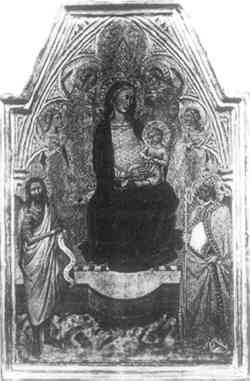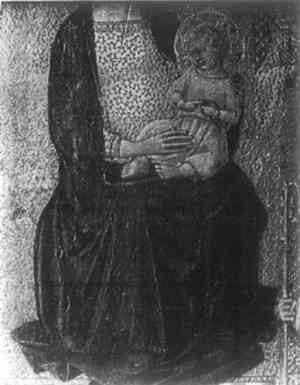THREE METHODS OF MODELLING THE VIRGIN'S MANTLE IN EARLY ITALIAN PAINTINGNorman E. Muller
4 NICCOL� DI BUONACCORSO'S METHOD OF MODELLINGA most unusual technique of modelling is found on a central panel of a triptych in the Museum of Fine Arts, Boston, attributed to Niccol� di Buonaccorso, a late fourteenth century Sienese artist, as shown in Figure 4. Executed in a two-value technique similar to that described previously, it is nevertheless completely different.
We can immediately perceive this distinction in a raking light photograph of the Virgin's mantle, as shown in Figure 5. A dark shade of blue, simulating the shadows, is raised above
An infrared photograph was taken of the Virgin's mantle, and the result, as shown in Figure 6, revealed a high infrared reflectance of the dark blue and a high absorption of the infrared rays by the greenish-blue areas. These characteristics, which were supported by photographic evidence obtained by color infrared photography,17 suggested the presence of ultramarine and azurite blue, respectively.18
Of the hundreds of Tuscan fourteenth century panel paintings that have been studied by the author in American and European collections, only three other paintings are known where this technique appears. One is Buonaccorso's Madonna of Humility in the Timken Art Gallery, San Diego, where the Virgin Annunciate's mantle in the pinnacle of the right wing was painted in this fashion. Another is Buonaccorso's Pieta in the Lehman Collection, New York; and the third example is Niccol� di Ser Sozzo Tegliacci's Madonna and Child in the Uffizi, Florence.19 Tegliacci, like Buonaccorso, was a Sienese painter, and his Uffizi panel originally came from the church of Sant'Antonio in Bosco in Poggibonsi, a small town close to Siena. With the exception of the Lehman painting, which was studied only with a hand lens, the other two paintings were photographed with color infrared film, which gave results similar to the Boston panel. The identification of the technique of modelling on the Tegliacci panel establishes an early date for the technique and, furthermore, connects it with the Lorenzetti workshop. Tegliacci's painting was probably executed in the early 1350's, shortly after the death of the Lorenzetti brothers in the plague of 1348. At the time of the dissolution of the shop, Tegliacci acquired approximately eight of Ambrogio's punching tools and one of Pietro's,20 which he used in fashioning his own halo designs. Two of these distinctive motif impressions of Ambrogio's appear in the Uffizi painting. To this it should be mentioned that Tegliacci also employed ritagliare or “marking out” in his paintings.21 This was a technique of re-establishing the original outline of the figure after the gold leaf had been laid by brushing a line of white lead paint over the superfluous leaf that had lapped over the incised line. The density of this outlining is clearly visible on X-radiographs. Research by the author has shown that the technique was restricted in Siena to the workshop of Pietro Lorenzetti, whereupon it was adopted by his students. Tegliacci, therefore, can be counted as a member of that workshop in his early years, and later transferred to the shop operated by Ambrogio. A more detailed study of this interesting technique is in preparation by the author. Buonaccorso's early artistic career is more obscure than Tegliacci's. Only a few documents from the 1370's mention him, and he signed only two works, one of which (the Marriage of the Virgin in the National Gallery, London) was completed in 1387, the year before his death. Yet despite the paucity of information surrounding this artist, scholars are in general agreement that his known works reveal a stylistic indebtedness to Ambrogio Lorenzetti. To this it can be added that his adoption of the unique method of modelling the Virgin's mantle, as found in three of his works, also connects him with Tegliacci, and from him to Ambrogio Lorenzetti. Buonaccorso's extensive use of sgraffito,22 which originally was introduced by Simone Martini in his Annunciation of 1333, was a dominant mode of Sienese design in the 1350's. The Maestro d'Ovile was perhaps the leading practitioner of this rich technique, and his adoption of it influenced a host of minor Sienese masters, among whom one can list Tegliacci, Bartolo di Fredi, Paolo di Giovanni Fei, Jacopo di Mino Pellicciaio and Niccol� di Buonaccorso. Furthermore, in Buonaccorso's small Crucifixion in Perugia, the border punchwork bears a motif that is strikingly similar to a punch While the discovery of a rare technique is in itself interesting, of particular fascination is the manner by which Buonaccorso indicated light and shade. This abbreviated system, which is the exact opposite of Cennino's technique of modelling in three values, in that here the artist worked up to the darks (it is similar in this respect to the second technique), compares with modelling techniques found in late thirteenth century painting. In this period, highlights were often rendered schematically by applying gold leaf in a striated fashion over the blue mantle. We find this technique in Duccio's Ruccellai Maesta of the late 1280's and Coppo di Marcovaldo's Madonna in Santa Maria dei Servi, Orvieto, which was executed a decade or two earlier. Leading Sienese artists in the following century were often looking back in time for modes of design and techniques that they could modify and incorporate in their own painting. Ambrogio Lorenzetti was one of the most inventive of these artists, and his Vico l'Abate Madonna of 1319, with its severely frontal placement, is based on earlier, Dugento representations of the Virgin. And the Uffizi Bari panels, which were once joined to a now lost central panel probably depicting Saint Nicholas of Bari, formed an altarpiece similar in design to Dugento rectangular dossals. An artist of the caliber of Ambrogio was continually looking to the past to enrich his own art, and this tradition he passed on to his students and followers, such as Tegliacci and Buonaccorso, who in their own manner continued to modify older technical methods. |


